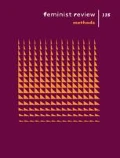University of Minnesota Press, published in Minneapolis and, London, 2006, 190pp., ISBN 0-8166-4635-X (Pbk)
Universality is a dangerous concept, says Grace Kyungwon Hong, one that has contributed to the rise of the US nation-state that privileges the propertied individual. This book addresses the shifts in US capital, from the national era to the global, from the nationalist mode of universality, to transnational modes in the form of a commodified fetishization of diversity. Grace Kyungwon Hong examines two key social formations – women of colour feminism and racialized immigrant women's culture – that emerge to mark the crises of each era of the US capital. She argues that these modes of universality occlude the modes of racialized and gendered difference on which they depend.
Contradictions of capital are multiple, she says, and they do not arise only from one totalizing structure of accumulation and over-accumulation. In part one, Hong argues that in the earlier era when capital reproduced itself through the racialized and gendered institutions of the nation-state, workers were recruited and disciplined through the universal category of citizenship, understood not only as a strictly legal category but also as a subject formation articulated via culture; that is, possessive individualism. Racialized and gendered difference is absolutely necessary to the hierarchization of workers and the extraction of capital in this era. Gender and race are constitutive of the operations of capital. Such articulations of difference are foreclosed by the notion of a universal and inclusive citizenship.
By reading texts by African American and Asian American women writers, Hong looks at the differential processes of racialization for African Americans and Asian Americans through private property relations. These writers articulate the possibility of alternative subjects, who are not modelled on the free willed, possessive individual.
In the second part of the book, Hong argues that in the Fordist era, capital also reproduced itself through racialized and gendered difference (but not through the extension of a universally available form of citizenship). ‘Difference’, instead, became articulated as a kind of commodification. Racialized immigrant women's culture attests to other sites of difference – emerging from the histories of neocolonialism and labour migration – that cannot be subsumed to the logic of commodification.
While in the early twentieth century rationality found expression in the totalizing logic of bureaucracy, in the latter half of the century the bureaucratic apparatus of Fordism proved too unwieldy. Post-Fordist capital retained and expanded on the consumer culture initiated in the Fordist era. In this new post-Fordist era, the logic of capitalism is differentiation, or ‘flexibility’ (‘the fetishisation of difference’).
Flexible accumulation – characteristic of this new era – adopts the strategy of mixing non-modern and modern forms of production. This, in practice, depends on and reproduces racialized and gendered exploitation. These inequities of power create a variety of differentiated relationships to late twentieth century world capitalism. As such, Hong argues that the late twentieth century capital cannot produce a totalizing commodified global culture as Jameson has argued. Capital, instead, produces a variety of differentiated and contradictory formations. Thus, the idea of ‘uneven development’ of world cultures.
Women of colour feminist practice and racialized immigrant women's culture emerge as the return of the repressed capital, naming the erasures at the very moment of articulation. Hong concludes that the histories of race and gender allow for potential: the emergence of organizational strategies and opportunities for change that go beyond the modes of traditional labour organizing modelled on the white working class of the early twentieth century. These histories of race and gender can create new sites of struggle where the impossible is imagined.
A refreshing read for all those studying race and gender.
Rights and permissions
About this article
Cite this article
Hong, G., Pai, HH. The ruptures of American capital. Fem Rev 90, 147–148 (2008). https://doi.org/10.1057/fr.2008.31
Published:
Issue Date:
DOI: https://doi.org/10.1057/fr.2008.31

